Where and how much salt should I put in the dishwasher?
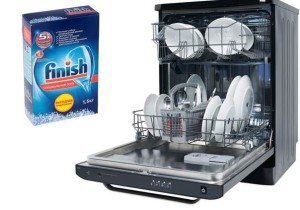 The dishwasher does a great job of cleaning dirty dishes, but it requires various products to do this, so be prepared to constantly buy them, spending a certain amount of your budget on it. All products used can be divided into two groups: those that are necessary for washing away contaminants, and the second group of products are products for softening hard water, or rather salt. We will talk further about how much salt, where and how often you need to put salt in the dishwasher.
The dishwasher does a great job of cleaning dirty dishes, but it requires various products to do this, so be prepared to constantly buy them, spending a certain amount of your budget on it. All products used can be divided into two groups: those that are necessary for washing away contaminants, and the second group of products are products for softening hard water, or rather salt. We will talk further about how much salt, where and how often you need to put salt in the dishwasher.
Variety of salts - how much to pour
Before answering the question of how much salt to put in the dishwasher, let’s decide what kind of salt you use for this. There are several options:
- special regenerating salt (for example, Finish, Somat, Calgonit, etc.);
- special tableted salt (Topperr);
- a substitute for special salt - evaporated salt "Extra", we have already talked about the pros and cons of replacing salt in the article about how to replace salt;
- tableted salt based on “Extra” salt.
On the packaging of specialized salt there are instructions for use, which states that the salt should be poured into the container to the top. Depending on the dishwasher model, the volume of the salt compartment may vary, so different amounts of salt may be included. Most machines hold 2/3 of a one and a half kilogram pack of regenerating salt.
As for regular salt, one kilogram pack is enough. You also need to pour in enough tablets to fill the container. The dishwasher itself will tell you how often you need to add salt by flashing the salt indicator. When it lights up, you need to add salt again.
Salt compartment
The question of where to put salt in the dishwasher should not be difficult. In all dishwashers, the salt compartment is located on the bottom of the dishwasher under the bottom tray. To pour granulated salt into it, you need to use a funnel.
Important! When adding salt to the dishwasher for the first time, you first need to fill the compartment with water. As salt is added, excess water will go down the drain.
As for 3-in-1 tablets containing salt, there is a special compartment for them. It is located on the inside of the door.
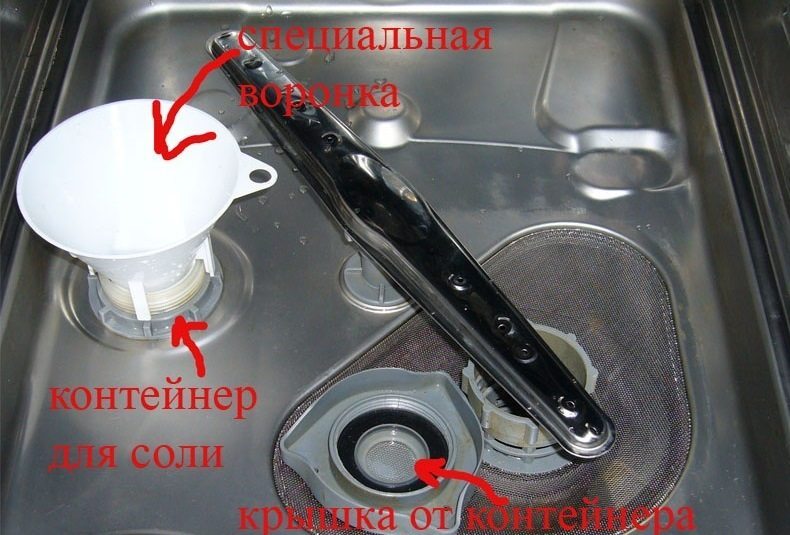
Water hardness and salt consumption
To soften water in a dishwasher, there is a special device in the form of a reservoir called an ion exchanger. Inside the ion exchanger there is a resin with negatively charged chlorine ions. These ions attract magnesium and calcium impurities contained in the water, and the water becomes softer. If this is not done, then at high temperatures magnesium and calcium form scale that settles on the heating element; in addition, dishes are washed less easily in hard water
But if the water in the dishwasher, passing through the ion exchanger, already becomes soft, then why do we need special salt? And then, in order to restore the amount of chlorine ions in the resin, that is why such salt is called regenerating. And the more hard water, the greater the salt consumption.
To determine water hardness, you can use one of the following methods.
- The method is “by eye”, that is, take laundry soap, foam it or lather it on some rag. If it doesn't wash well and doesn't rinse well, then the water is hard. Also, pay attention to how quickly limescale builds up on faucets, toilets, and other surfaces.The faster, the harder the water.
- The second method involves using a special device or test strip. The most accurate and simplest option.
Important! Water hardness changes with the seasons, so it is best to carry out your own measurements several times a year.
- And the last method invites us to look at the rigidity in the table by region, compiled by experts.
According to hardness, water is classified into:
- soft;
- medium hardness;
- hard;
- very tough.

How to correctly adjust salt consumption in the dishwasher based on water hardness? First, read the instructions, they usually describe the entire process. So, for example, in Bosch brand dishwashers you can set 7 levels of water hardness. When the salt runs out, the indicator on the panel will light up, which means you need to add salt again. If you use tablets containing salt, the no-salt indicator can be turned off by setting the water hardness to 0.

But we note that even among Bosch machine models, when the hardness is set to 0, water can pass not bypassing the ion exchanger, but through it. And if you do not add salt, but only put in tablets containing salt, this can lead to the ion exchanger becoming clogged, and water will not flow at all; as a result, the unit will need to be changed. Therefore, salt is needed not only to soften water and improve the quality of washing, but also to maintain the dishwasher’s ion exchanger in working condition.
Important! Manufacturers of Bosch brand dishwashers recommend using 3-in-1 tablets only with a hardness level of less than 210dH, if the hardness is greater, then you need to add salt and detergent separately.
Thus, it is not so important how much salt you pour into the dishwasher compartment, it is important that it is always there. How often you will have to do this will depend on the water hardness in the region and whether the hardness settings on the dishwasher itself are set correctly. We hope that this article was useful to you.
Interesting:
22 reader comments


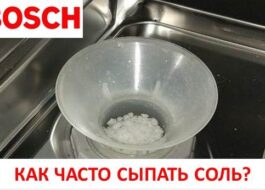
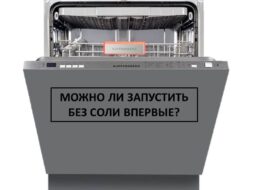
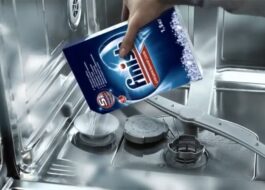

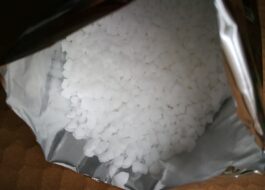














I unscrewed the lid from the compartment where the salt was poured, and water, literally under pressure, poured out of the hole. Moreover, the machine now washes dishes very poorly. Maybe something is broken or clogged? Please tell me.
Hello, same story, I don’t know what to do...
There should be water in the salt compartment all the time, just pour salt in and the water flows out. Without salt and rinse aid it will always be bad to wash.
The dishes are not washed, what should I do? And in the salt compartment there is up to the neck of water, how to add salt?
Just add salt and the water will flow down the drain! That's how it should be)))
If the dishes are not washed well, and the machine is covered in deposits, then I read that you need to buy a cleaner. For example Finish. Peel off the sticker on the lid and place it in the PMM with the lid down, turning on the washer at the highest temperature.
It's called wax cleaner
Somehow the water leaked out of the tank, leaving only salt. Now, before loading the machine, do you need to pour water or will it fill it in itself?
I accidentally poured dishwasher powder into the salt compartment. So what's now? Will the machine be damaged now?
The articles say that this is bad. It might break. Be sure to contact the workshop. They will come or give you advice over the phone.
Where should I put the gel? In the same compartment as the tablet?
Yes
On the first run, the dishwasher did not pour water, but simply added salt. After half an hour of washing out of a 3-hour cycle, it began to squeak and gave an e4 error. When I read that you need to pour water into salt. I did. Now when you open the lid in the compartment with salt, the water is at the neck. Could this error be due to the fact that I did not pour water?
The salt ran out after 6-7 washes. Those. The low salt indicator comes on. Before the 1st load, I added 1 kg, as indicated in the instructions, with water. Was it used up so quickly? Electrolux machine with 10 hardness levels. Hardness 8. How often does someone add salt?
Natalia, I have about the same thing too.
I still couldn’t figure out exactly how much salt to put in the container; before that I washed dishes without salt, but there were stains on the dishes, especially Teflon ones.The instructions say “fill the container”, and the water will be forced out into the drain, in fact, this is what happened, my entire pack of 1.5 kg of Somat flew in, but I still didn’t see the top. It feels like it would still fit. Bosch SMV47L10 dishwasher, I couldn’t find the salt container in the instructions. Next time I’ll buy two packs and see how many fit :)
I don’t quite understand, when you pour salt into the compartment, do you always need to set the hardness level? Or only when the machine is started for the first time? Then just add as needed?
Alena, the hardness level is set only once. There is no point in changing it if your water quality has not changed.
Good afternoon. Please tell me how often should I add salt? During the first load I added water and salt. The hardness is set to 4. More than 40 wash cycles have already passed, but the salt shortage indicator still does not light up. I use 3 in 1 tablets. Candi machine. Is it worth adding salt “forcibly”?
Thank you.
Hansa dishwasher. The instructions tell you how to fill the compartment with loose salt. I just can’t find how much tablet salt to put in. Can anyone tell me?
Natalia, open the lid of the salt compartment, stick your finger in and try to see if there is salt at the bottom, as there must be some. If you don’t feel it in the water or there is only a little, then be sure to add more, and let the excess water pour out of the salt compartment.
Hansa dishwasher. We didn’t use the machine for three months, and after turning it on the salt indicator came on. I bought a 1.5 kg pack of finish. After the first wash, the salt literally disappeared from the compartment. I didn't find her there. The indicator came on again, I called the repairman, he came, looked, was surprised and told me to buy more salt. I bought 3 kg of salt, added 1.5, after washing the indicator came on again, all the dishes were heavily stained, but the salt was gone. What is the problem here, can anyone tell me?